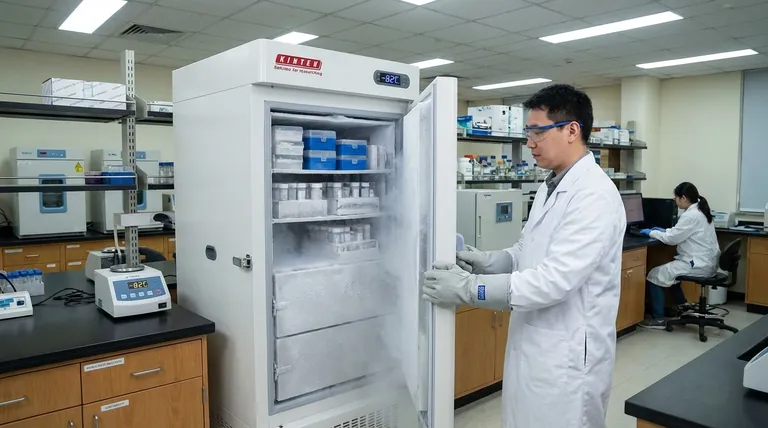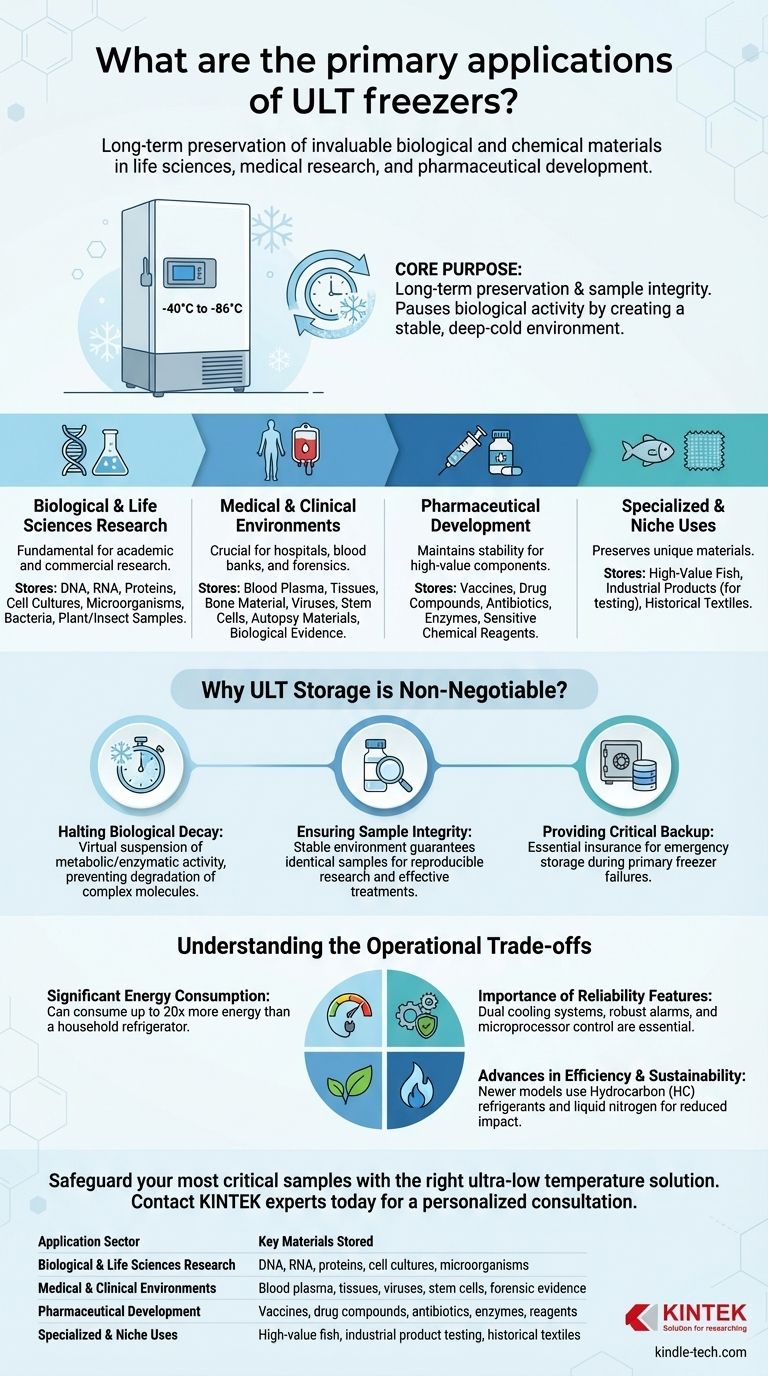At their core, ultra-low temperature (ULT) freezers are designed for one primary purpose: the long-term preservation of invaluable biological and chemical materials. They are essential in any field where sample integrity is non-negotiable, serving critical functions in life sciences, medical research, and pharmaceutical development by storing everything from DNA and vaccines to sensitive reagents and tissue samples.
The central challenge is that standard freezing is insufficient to halt the slow degradation of sensitive biological materials over time. ULT freezers solve this by creating an extremely stable, deep-cold environment (typically -40°C to -86°C) that effectively pauses biological activity, ensuring the viability and integrity of irreplaceable samples for years or even decades.

Core Applications Across Critical Sectors
The use of ULT freezers is concentrated in fields where the long-term stability of biological specimens is paramount. Their application is a direct reflection of the value and sensitivity of the materials being stored.
Biological and Life Sciences Research
In academic and commercial research, ULT freezers are fundamental. They are the libraries for biological data.
Researchers in universities, biotech companies, and government labs rely on them to store DNA, RNA, proteins, and cell cultures. They also preserve microorganisms, bacteria, and unique plant or insect samples for future study.
Medical and Clinical Environments
Hospitals, blood banks, and forensic laboratories depend on ULT freezers for the safe storage of critical human-derived materials.
This includes blood plasma, tissues, bone material, viruses, and stem cells. In forensics, they preserve autopsy materials and other biological evidence, ensuring it remains untainted for analysis.
Pharmaceutical Development
The pharmaceutical industry uses ULT freezers to maintain the stability of high-value components throughout the long research and development cycle.
They are used to store vaccines, drug compounds, antibiotics, enzymes, and sensitive chemical reagents. This ensures that materials used in trials and manufacturing are consistent and effective.
Specialized and Niche Uses
Beyond the primary fields, ULT freezers serve several specialized functions.
These applications include preserving high-value fish in the deep-sea fishing industry, testing the reliability of industrial products under extreme cold conditions, and even the long-term preservation of historical textiles.
Why ULT Storage is Non-Negotiable
The decision to use a ULT freezer is driven by the need to eliminate risk. For many samples, degradation is not a possibility but an inevitability without extreme cold, rendering research invalid or therapies ineffective.
Halting Biological Decay
The fundamental principle of ULT storage is that at temperatures approaching -86°C, nearly all metabolic and enzymatic activity ceases.
This virtual suspension of biological processes prevents the gradual breakdown of complex molecules like DNA, RNA, and proteins, which would otherwise degrade even in a standard freezer.
Ensuring Sample Integrity and Viability
For research to be reproducible and for medical treatments to be effective, the stored sample must be identical to the original.
ULT freezers provide the stable environment needed to guarantee this integrity, preventing temperature fluctuations that could compromise sample viability and lead to wasted time, resources, and data.
Providing Critical Backup and Redundancy
ULT freezers also serve as a crucial insurance policy. They are used for emergency storage of critical materials.
In the event of a primary freezer failure or other unforeseen emergency, having backup samples safely stored in a separate ULT unit can prevent the catastrophic loss of years of valuable research.
Understanding the Operational Trade-offs
While essential, ULT freezers are specialized, high-performance machines with significant operational considerations. Understanding these trade-offs is key to managing them effectively.
Significant Energy Consumption
Reliable deep-cold requires powerful technology. Traditional cascade refrigeration systems can consume up to 20 times more energy than a standard household refrigerator.
This makes energy consumption a major factor in the total cost of ownership and a significant environmental consideration for any institution.
The Importance of Reliability Features
The high value of the stored contents means that equipment failure is not an option.
Modern ULT freezers incorporate features like dual cooling systems for redundancy, microprocessor-controlled temperature management, and robust alarm systems that notify staff of power outages or temperature deviations.
Advances in Efficiency and Sustainability
To address high energy costs, manufacturers have made significant strides in efficiency.
Newer models often use hydrocarbon (HC) refrigerants like propane and ethane, which are more efficient than older CFC/HFC systems. Some advanced units even use liquid nitrogen technology, drastically reducing energy consumption and environmental impact.
Making the Right Choice for Your Goal
Your approach to ultra-low temperature storage should be dictated by the value of your samples and your operational constraints.
- If your primary focus is routine clinical storage: Your main concern is reliability and temperature stability, making features like dual cooling systems and robust alarm systems paramount.
- If your primary focus is long-term academic research: You need to balance sample integrity with operational cost, so exploring newer, energy-efficient models with hydrocarbon refrigerants is crucial.
- If your primary focus is high-value pharmaceutical development: The absolute priority is preventing sample loss, justifying investment in top-tier units with comprehensive data logging and backup systems.
Ultimately, a ULT freezer is not just an appliance; it is an insurance policy for irreplaceable scientific and medical assets.
Summary Table:
| Application Sector | Key Materials Stored |
|---|---|
| Biological & Life Sciences Research | DNA, RNA, proteins, cell cultures, microorganisms |
| Medical & Clinical Environments | Blood plasma, tissues, viruses, stem cells, forensic evidence |
| Pharmaceutical Development | Vaccines, drug compounds, antibiotics, enzymes, reagents |
| Specialized & Niche Uses | High-value fish, industrial product testing, historical textiles |
Safeguard your most critical samples with the right ultra-low temperature solution.
At KINTEK, we understand that your research and development depend on the integrity of your biological and chemical materials. Our range of reliable and efficient ULT freezers is designed to meet the demanding needs of laboratories in life sciences, clinical, and pharmaceutical sectors. We provide the equipment you need to ensure long-term sample viability and protect your invaluable work.
Ready to find the perfect ULT freezer for your lab's requirements? Contact our experts today for a personalized consultation and discover how KINTEK can support your laboratory's mission.
Visual Guide

Related Products
- 58L Precision Laboratory Ultra Low Temperature Upright Freezer for Critical Sample Storage
- 408L Advanced Vertical Laboratory Ultra Low Temperature Freezer for Critical Research Material Preservation
- 508L Advanced Vertical Ultra Low Temperature Freezer for Critical Laboratory Storage
- 608L Essential Laboratory Ultra Low Temperature Freezer For Critical Sample Preservation
- 708L Ultra Low Temperature Freezer High Performance Laboratory Freezer
People Also Ask
- How do Ultra-Low Temperature freezers ensure the integrity of microbiological samples? Maintain Stability for Critical Research
- What temperature range do Ultra-Low Temperature freezers maintain? The -80°C Standard for Sample Integrity
- What temperature range do Ultra-Low Temperature (ULT) freezers typically maintain? Preserve Your Samples from -40°C to -86°C
- What are ultralow temperature freezers and what are they used for? Preserve Critical Samples for Decades
- What are the common designs of ultra-low temperature freezers? Upright vs. Chest Models for Your Lab



















